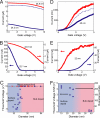Diameter-dependent dopant location in silicon and germanium nanowires
- PMID: 19706402
- PMCID: PMC2730964
- DOI: 10.1073/pnas.0906943106
Diameter-dependent dopant location in silicon and germanium nanowires
Abstract
We report studies defining the diameter-dependent location of electrically active dopants in silicon (Si) and germanium (Ge) nanowires (NWs) prepared by nanocluster catalyzed vapor-liquid-solid (VLS) growth without measurable competing homogeneous decomposition and surface overcoating. The location of active dopants was assessed from electrical transport measurements before and after removal of controlled thicknesses of material from NW surfaces by low-temperature chemical oxidation and etching. These measurements show a well-defined transition from bulk-like to surface doping as the diameter is decreased <22-25 nm for n- and p-type Si NWs, although the surface dopant concentration is also enriched in the larger diameter Si NWs. Similar diameter-dependent results were also observed for n-type Ge NWs, suggesting that surface dopant segregation may be general for small diameter NWs synthesized by the VLS approach. Natural surface doping of small diameter semiconductor NWs is distinct from many top-down fabricated NWs, explains enhanced transport properties of these NWs and could yield robust properties in ultrasmall devices often dominated by random dopant fluctuations.
Conflict of interest statement
The authors declare no conflict of interest.
Figures




References
-
- Sze SM. Semiconductor Devices Physics and Technology. New York: Wiley; 2002.
-
- Singh J. Semiconductor Optoelectronics Physics and Technology. New York: McGraw-Hill; 1995.
-
- Erwin SC, et al. Doping semiconductor nanocrystals. Nature. 2005;436:91–94. - PubMed
-
- Dalpian GM, Chelikowsky JR. Self-purification in semiconductor nanocrystals. Phys Rev Lett. 2006;96:226802. - PubMed
-
- Feng X, et al. Converting ceria polyhedral nanoparticles into single-crystal nanospheres. Science. 2006;312:1504–1508. - PubMed
Publication types
MeSH terms
Substances
LinkOut - more resources
Full Text Sources

